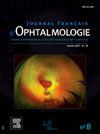L’OCT-angiographie dans le diagnostic du glaucome – une étude cas-témoin multicentrique
IF 1.1
4区 医学
Q3 OPHTHALMOLOGY
引用次数: 0
Abstract
But
Notre objectif a été de comparer la densité vasculaire (DV), obtenue par l’OCT-angiographie (OCTA), entre patients glaucomateux et patients sains.
Matériel et méthodes
Nous avons réalisé une étude prospective, cas-témoin, multicentrique. Tous les patients ont eu une consultation d’ophtalmologie complète et champs visuels (CV), OCT, et OCTA. Nous avons utilisé des critères d’inclusion et exclusion stricts. Nous avons utilisé un logiciel de quantification de DV.
Résultats
Au total, 91 patients ont été inclus dans cette étude, dont 37 témoins et 54 cas, avec 52,7 % de femmes et une moyenne de 70,37 ± 9,72 ans. La DV péripapillaire moyenne était de 81,0 ± 10,5 % chez les témoins et 76,2 ± 14 % pour les glaucomateux (p = 0,01). La DV maculaire médiane était de 41,33 % [IQR 40,58–42,15] chez les témoins, et 41,96 % [IQR 40,12–43,06] dans les glaucomes, p = 0,44, non significative (excepté pour la DV maculaire nasale). La déviation moyenne (MD) des CV, la DV et l’épaisseur de fibres nerveuses ont été statistiquement différents dans les deux groupes. L’aire sous la courbe (AUROC) a été de 0,16 pour le RNFL, 0,30 pour le MD et 0,30 pour la DV péripapillaire.
Discussion et conclusion
Cette étude a montré une réduction de la DV péripapillaire dans le glaucome. La DV maculaire a été similaire. La reproductibilité de la DV dans les deux centres a été bonne. L’AUROC de l’OCTA a été supérieure à celle de l’OCT et des CV, montrant le potentiel diagnostic de l’OCTA dans le glaucome. Néanmoins, c’est une AUROC faible, ce qui confirme l’importance de la clinique.
Purpose
We aimed to compare the vascular density (VD) obtained by OCT-angiography (OCTA) in glaucoma patients versus healthy controls.
Methods
We performed a multicenter prospective case-control study. All patients underwent a complete ophthalmologic examination with visual fields (VF), OCT, and OCTA. We used strict selection criteria. We used software to quantify the VD.
Results
We included 91 patients, consisting of 37 controls and 54 cases, with 52.7% females and a mean age of 70.37 ± 9.72 years. Mean peripapillary VD was of 81.0 ± 10.5% in controls and 76.2 ± 14% in glaucoma (P = 0.01). The median macular VD was 41.33% [IQR 40.58–42.15] in controls versus 41.96% [IQR 40.12–43.06] in glaucoma, P = 0.44, non-significant (except for the nasal sector). Mean deviations in VF, VD and OCT RNFL were statistically significantly different in glaucoma. The area under the curve (AUROC) was 0.16 for RNFL, 0.30 for MD and 0.30 for peripapillary VD.
Discussion and conclusion
This study showed a reduction in peripapillary VD in glaucoma. Macular VD was similar. There was good reproducibility between VD in both centers. The AUROC of OCTA was superior to that of OCT and VF, demonstrating a good diagnostic utility in glaucoma. Nevertheless, this AUROC was globally week, corroborating the fact that clinical examination is fundamental.
CCT血管造影在青光眼诊断中的作用-多中心病例对照研究
我们的目标是比较青光眼患者和健康患者通过OCTA获得的血管密度(VD)。我们进行了一项前瞻性的、以案例为基础的、多中心的研究。所有患者都接受了全面的眼科和视场(CV)、CT和OCTA咨询。我们使用了严格的纳入和排除标准。我们使用了DV量化软件。增长共91人,患者也列入了这项研究,其中37名证人和54例,占52.7%,与女性平均70.37±。《DV péripapillaire劳动者的年平均为81.0±10.5%的对照和76.2%为14±glaucomateux (p = 0.01)。对照组中位黄斑DV为41.33% [QR 40.58 - 42.15],青光眼组中位黄斑DV为41.96% [QR 40.12 - 43.06], p = 0.44,不显著(鼻黄斑DV除外)。两组的平均简历偏差(MD)、DV和神经纤维厚度有统计学差异。RNFL的曲线下面积(AUROC)为0.16,MD为0.30,DV为0.30。本研究显示青光眼中乳头周围DV减少。黄斑DV也类似。这两个中心的VD重现性良好。OCTA的AUROC优于CTA和resume,显示了OCTA在青光眼中的诊断潜力。然而,这是一个低AUROC,这证实了临床的重要性。目的:我们的目的是比较开放血管造影(OCTA)在青光眼患者中获得的血管密度(VD)与健康对照。方法:我们进行了多中心前瞻性病例对照研究。所有患者都接受了视觉场(VF)、OCT和OCTA的完整眼科检查。我们使用严格的选择标准。我们使用软件来量化VD。结果我们包括91例患者,包括37例对照组和54例,其中52.7%为女性,平均年龄为70.37±9.72岁。对照组平均周长VD为81.0±10.5%,青光眼患者平均周长VD为76.2±14% (P = 0.01)。对照组中位黄斑VD为41.33% [IQR 40.58 - 42.15],而青光眼患者中位黄斑VD为41.96% [IQR 40.12 - 43.06], P = 0.44,无显著性(鼻部除外)。青光眼中VF、VD和OCT RNFL的平均偏差在统计上有显著差异。曲线下的面积(AUROC)为RNFL 0.16, MD 0.30,周边VD 0.30。这项研究显示青光眼周围VD降低。黄斑VD类似。这两个中心的VD之间的复制性都很好。OCTA的AUROC优于OCT和VF,显示出对青光眼的良好诊断效用。尽管如此,这次AUROC在全球范围内持续了一周,证实了临床检查是至关重要的。
本文章由计算机程序翻译,如有差异,请以英文原文为准。
求助全文
约1分钟内获得全文
求助全文
来源期刊
CiteScore
1.10
自引率
8.30%
发文量
317
审稿时长
49 days
期刊介绍:
The Journal français d''ophtalmologie, official publication of the French Society of Ophthalmology, serves the French Speaking Community by publishing excellent research articles, communications of the French Society of Ophthalmology, in-depth reviews, position papers, letters received by the editor and a rich image bank in each issue. The scientific quality is guaranteed through unbiased peer-review, and the journal is member of the Committee of Publication Ethics (COPE). The editors strongly discourage editorial misconduct and in particular if duplicative text from published sources is identified without proper citation, the submission will not be considered for peer review and returned to the authors or immediately rejected.

 求助内容:
求助内容: 应助结果提醒方式:
应助结果提醒方式:


